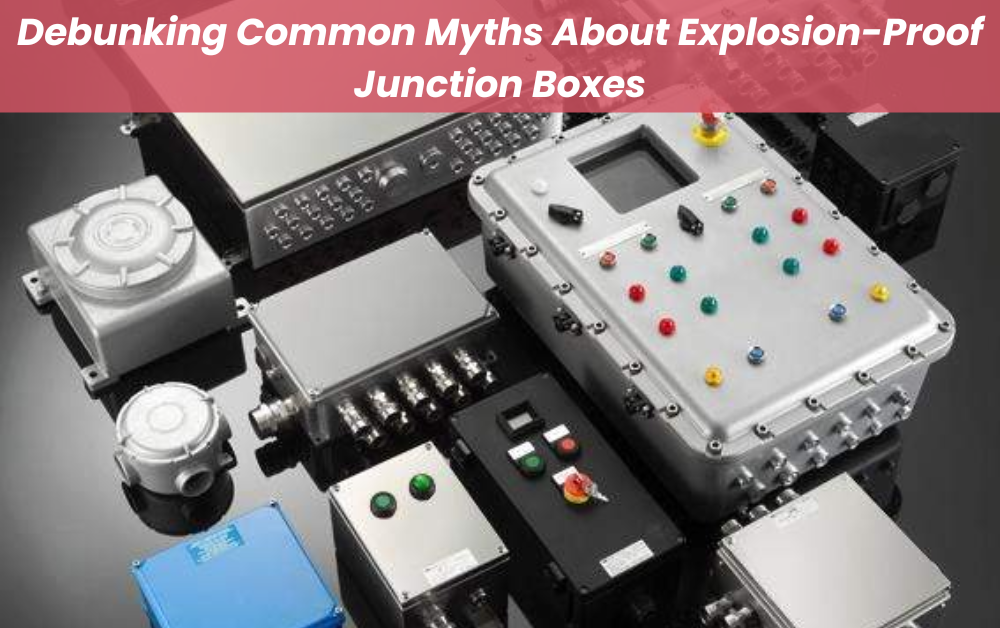Introduction
Explosion-proof junction boxes are the unsung heroes of hazardous environments, safeguarding lives and assets from potential catastrophe. Yet, these critical safety components often find themselves shrouded in myths and misconceptions. In this enlightening journey, we’ll unravel these myths one by one, providing clarity and dispelling misconceptions about explosion-proof junction box.
Myth 1 – Explosion-Proof Junction Boxes Are Overpriced
Myth Explanation
One of the most common myths surrounding explosion-proof junction boxes is the belief that they come with an exorbitant price tag. Many individuals and industries hesitate to invest in explosion-proof equipment due to this widespread misconception. The thought of incurring substantial costs can deter even the most safety-conscious individuals.
Reality Check
Let’s set the record straight. While it’s true that explosion-proof junction boxes may have a higher initial cost compared to standard enclosures, they are far from overpriced. The expense is an investment in safety and risk mitigation. These boxes are engineered to withstand hazardous conditions, preventing potential explosions and protecting lives and assets.
Moreover, consider the long-term cost savings. By avoiding disasters, downtime, and damage to equipment, explosion-proof junction boxes prove their worth over time. In essence, they are a cost-effective choice when you evaluate the comprehensive safety they offer.
Myth 2 – Any Electrical Enclosure Can Be Used
Myth Explanation
Another myth that circulates in discussions about explosion-proof junction boxes is the belief that standard electrical enclosures can be used interchangeably. This misconception is not only incorrect but also dangerous. Some individuals assume that a regular electrical enclosure can provide the same level of protection in hazardous environments, leading to risky decisions.
Reality Check
The reality is quite different. Explosion-proof junction boxes are purpose-built for hazardous conditions. They are constructed with specialized materials and designs that can contain explosions within the enclosure, preventing them from igniting the surrounding atmosphere. Standard enclosures lack these critical safety features and should never be substituted in hazardous areas.
In hazardous environments where flammable gases, vapors, or combustible dust are present, the use of explosion-proof junction boxes is not just a best practice; it’s a legal requirement in many regions. Cutting corners with standard enclosures can have dire consequences.
Myth 3 – All Explosion-Proof Junction Boxes Are the Same
Myth Explanation
Some individuals mistakenly assume that all explosion-proof junction boxes offer identical protection. This myth can lead to the incorrect belief that choosing any box off the shelf will suffice, regardless of the specific hazardous conditions in play.
Reality Check
Explosion-proof junction boxes come in various designs, each tailored to specific hazardous environments. Factors like the type of hazardous materials, the presence of dust, and the temperature range can significantly impact the choice of junction box. For example, a junction box suitable for a petrochemical plant may not be the right choice for a mining operation.
Choosing the right box requires a thorough understanding of your unique requirements and the hazardous conditions in your environment. Consulting with experts and selecting a box that aligns with your specific needs is crucial to ensure safety and compliance.
Myth 4 – Certification Doesn’t Matter
Myth Explanation
Perhaps one of the riskiest myths is the belief that certifications for explosion-proof junction boxes are unimportant. Some individuals may assume that certifications like ATEX or UL are mere formalities and that any box will do the job.
Reality Check
Certifications are the cornerstone of safety when it comes to explosion-proof equipment. Certifications like ATEX (European Union) and UL (Underwriters Laboratories) are rigorous and ensure that the junction boxes meet stringent safety standards. Choosing a certified box provides assurance that it has undergone rigorous testing and adheres to industry-specific safety requirements.
Furthermore, regulatory authorities often require the use of certified explosion-proof equipment in hazardous environments. Failing to comply with these regulations can result in legal consequences and, more importantly, compromise the safety of personnel and assets.
Myth 5 – Maintenance Isn’t Essential
Myth Explanation
The final myth we’ll debunk is the misconception that explosion-proof junction boxes don’t require regular maintenance. Some may assume that once installed, these boxes can be forgotten and left to function indefinitely.
Reality Check
Maintenance is not just essential; it’s paramount for explosion-proof junction boxes. These critical safety components require routine inspections and upkeep to ensure their continued functionality. Neglecting maintenance can have dire consequences, including the risk of component failure or degradation of safety features.
Routine inspections allow for the early detection of issues, such as corrosion or wear and tear, which can compromise the integrity of the box. Additionally, periodic maintenance can include tasks like cleaning, lubricating, and replacing worn components, ensuring that the junction box remains reliable in the face of hazardous conditions.
In conclusion, the myths surrounding explosion-proof junction boxes are not just misconceptions; they can pose significant risks in hazardous environments. By dispelling these myths and embracing the reality of these critical safety components, individuals and industries can make informed decisions that prioritize safety above all else.
Conclusion
In conclusion, the myths that surround explosion-proof junction boxes are not just innocent misconceptions; they can have severe consequences in hazardous environments. By dispelling these myths and embracing the reality of these critical safety components, individuals and industries can make informed decisions that prioritize safety above all else.
Understanding the truth about explosion-proof junction boxes is not only a matter of compliance but a moral responsibility to protect lives, assets, and the environment. Let’s recap the myths we’ve debunked and the important takeaways:
- Myth 1 – Explosion-Proof Junction Boxes Are Overpriced: In reality, they are a wise investment in safety, with long-term cost savings and disaster prevention benefits.
- Myth 2 – Any Electrical Enclosure Can Be Used: The reality is that standard enclosures lack essential safety features and should never replace explosion-proof junction boxes in hazardous areas.
- Myth 3 – All Explosion-Proof Junction Boxes Are the Same: Different environments require different types of junction boxes. Choose wisely based on your specific needs.
- Myth 4 – Certification Doesn’t Matter: Certifications like ATEX and UL are not just formalities; they ensure compliance with rigorous safety standards and legal requirements.
- Myth 5 – Maintenance Isn’t Essential: Regular maintenance is crucial to ensure the continued functionality and safety of explosion-proof junction boxes.



